«previous pageANALYSIS & PLANNING CATEGORY
Honor Award
A Civic Vision and Action Plan for the Central Delaware River,
Philadelphia, PA
Wallace Roberts & Todd, LLC, Philadelphia, PA
client: PennPraxis
Project Statement
Built from a truly collective process, this plan advances a powerful civic vision and clearly outlines implementation strategies for the central Delaware River, in which:
- Underserved, isolated neighborhoods and frayed ecological networks
are inter-connected and reconnected to theriver; - The river’s potential in supporting sustainable regional growth is realized
by balancing development and a world class park system; - And, in which, public will is given voice to change a city’s future.
Project Narrative
Background
Focusing on seven miles of the Delaware River along Philadelphia the vision advances excellence in urban design, policy, regulations and development. Authorized by a 2006 mayoral executive order and funded by the Environment and Communities Program of the William Penn Foundation, the Civic Vision was unveiled in November 2007, with the original document supplemented by the Action Plan for the Central Delaware: 2008-2018 last June. The client and consultant team developed a planning process intended to cut through decades of incremental property deals and ill considered infrastructure. Plan goals and principles were derived — and plan developments vetted — from the aspirations of more than four thousand citizens, through a year-long, large scale, open and transparent process led by the University of Pennsylvania’s Project for Civic Engagement. The hallmark of the project was the public discussion, with a series of riverfront walks and community forums to elicit goals and the following five civic principles:
- Reconnect the city to the river’s edge
- Honor the river
- Design with nature
- Strike the right balance
- Take the long view
- Protect the public good
- Make it real, Philadelphia
Process and Proposals
The plan’s carefully designed planning process was rooted in best practices and the expertise of a multi-disciplinary team of academics, consultants, NGO’s, and public sector agencies. To ensure ownership in the plan at all levels and the greatest likelihood for implementation, the project team engaged government and civic groups at all stages. Those groups included transportation and transit agencies, the City’s Office of Watersheds, district stakeholders, community leaders in design and development, and the general public. All were engaged in a robust series of technical and design workshops and monthly advisory group meetings.
The planning process began with in-depth analysis of the historical, cultural, ecological, and economic contexts. Using data — from PA Department of Conservation and Natural Resources, the Philadelphia City Planning Commission, historic development and insurance maps and hydrology maps — the team created a series of synthetic maps identifying areas of environmental importance, cultural significance and economic opportunity.
Major engagement events included a 3-day charrette that drew an audience of 500 and involved relevant state and local agencies, civic associations, community stakeholders, the development community and national and international design experts. The process established among the charrette participants resulted in development of a flexible framework for growth, based on three networks:
- Movement Systems: streets, public transit and trails
- Parks and Open Space: parks and ecological systems
- Land Development: mix of uses and income levels
The Civic Vision for the Central Delaware emphasizes the interconnectedness of our ecological and urban networks. This interconnectedness is revealed through the development of the three networks comprising the plan framework. The plan seeks to ensure environmental function and public access through the creation of: 11 new parks and a riverfront greenway of over 300 acres; ecological restoration of the riverbank where habitat creation is viable; a multi-use trail; and an extensive, pedestrian-friendly network of streets that includes transit and a grand civic boulevard. These improvements provide a development framework for over 500 acres for which design and implementation guidelines are provided to extend the urban fabric to the river.
Context
Historic Context: Philadelphia has a long history of integrating parks and civic landscapes into the development of the city. This plan is conceived within the city’s historical context as well as the physical context of William Penn and Thomas Holme’s plan of 1683 — an egalitarian grid of streets, squares and access to the rivers. The Central Delaware Vision Plan responds to the benefits of such a grid and integrates best practices for green streets, stormwater management, continuous riverfront access, and riverfront parks. Pedestrian access from residential neighborhoods is stressed, providing connections approximately every 2,000 feet. In this plan the city’s historical “broad” east-west streets become green streets connecting to the river and terminating as parks.
Contemporary Context: Notably, the Delaware waterfront is severed from miles of flanking neighborhoods by I-95 and other circulation infrastructure. At some points, more than five hundred feet of asphalt and speeding cars intervene. In the central part of the city the plan explores options for burying I-95 and extending the city grid over it. Concepts for linear parks under a rebuilt I-95 and innovative stormwater management areas and green sound walls were also explored.
Many of the river ward neighborhoods suffer from environmental injustices: they are among the most underserved in the city in terms of recreation; I-95 is a known disease vector (due to the air pollution it brings); frequent flooding and combined sewer back-ups compromise housing and quality of life. The park and open space network recommendations of the plan address these issues, as described below.
Adaptive Re-use and Interpretation: With most of the industrial context already erased, the plan retains the few remaining artifacts and integrates them into public landscapes, such as at Penn Treaty and Pulaski Parks. At Penn Treaty Park the Power Plant becomes a cultural center at a restored river’s edge; at Pulaski Park the historic gantries, pier structures, and water inlets become part of a tidal wetland park.
Environmental Sensitivity and Sustainability
Histories of Philadelphia’s riverfront are often focused on industrial might, but Philadelphia also has a rich history of environmental foresight. With the development of the “Green Country Town” plan by Penn and Holme in 1683, the creation of Fairmount Park in 1855 to protect the City’s water supply and the establishment of the Benjamin Franklin Parkway, Philadelphia has, in moments, been at the forefront of environmental transformation. This generation’s moment is the revitalization of the central Delaware River.
The plan seeks to advance sustainability at the local level, through creating mutually supporting roles for ecological and urban networks, and at the regional level by shifting market demand to more sustainable growth. Positioning the area for development of mixed-use residential neighborhoods, the plan seeks to focus regional growth back into the city. The consultant team worked closely with the City’s Department of Watersheds and the State, identifying locations for inter-tidal wetlands, other riparian habitats and parkland, creating an extensive parks and open space network. This network ensures public access to the riverfront through the integration of access in zoning, establishment of conservation easements, acquisition of land for parks, restoration of the river’s edge, and the creation of intertidal wetlands, other riparian habitats and a continuous riverfront trail.
This environmental network is planned for integration with economic and social change, bringing housing on some of the piers, and mixed-use development within 150 feet of the river’s edge. The proposed 300 additional acres of parkland will add value to the neighborhoods that currently adjoin the river and will be an asset for future generations. The proposed parkland will support active and passive recreation, stormwater management, wildlife habitat, and other critical ecological functions.
Successful Implementation
Challenges: The Civic Vision was unveiled at end of one mayor’s administration and required the support of an incoming administration to work towards a successful implementation. To ensure the vision would be adopted under a new mayor, implementation relies upon on multi-level stakeholder involvement, public momentum, and an Action Plan document that focused on the vision’s short-and mid-term actions. The biggest challenges to implementation of the vision are the politics of the management agency and that significant changes to public policy are required to deploy regulatory tools that would provide for connected greenways and parkland.
Sustained Momentum: Indications of the sustained momentum around the plan are interest from the public and local media, three major Philadelphia City Planning Commission (PCPC) initiatives: GreenPlan Philadelphia, a comprehensive plan for sustainable open space; Imagine Philadelphia, the public participation process for the city’s comprehensive plan; and the Zoning Code Commission, charged with reform of the City’s antiquated zoning code, and the endorsement of the vision and action plan by Mayor Nutter. In June 2008, Mayor Nutter and the newly-appointed Deputy Mayor of Planning and Economic Development, Andy Altman, made the Civic Vision the focus of series of policy speeches on planning and design in the city.
"For more than a generation, the Delaware waterfront has been the target of big ideas that went nowhere," Nutter said. Focusing on the fact that the plan came out of a broad civic engagement process, he declared, "I share your vision for our waterfront," and continued by saying, "Tonight, we talk about a Declaration on the Delaware."
Setting the Stage for Success: As identified in the Action Plan's first of ten steps designed to implement the vision for the Delaware River over the next ten years, a new waterfront agency, the Delaware River Waterfront Corporation was Nutter's first policy action for the waterfront. The new agency was announced before a audience of over 500 at the waterfront’s Seaport Museum last summer. This January Mayor Nutter convened the new formed organization with a representative board of directors that continues the plan’s and administration’s commitment to transparency.
Ongoing Efforts
For citizens and development community, the implementation of this plan is just beginning. Dialogue with the development community has continued, as the city prepares an overlay zoning district for the waterfront and work on a waterfront access plan is scheduled for 2009. Redesign for one of the existing parks is underway; the local port authority that runs commuter trains into the city has recently announced study of transit development on the riverfront boulevard, and GreenPlan Philadelphia is set for adoption this Spring, identifying the waterfront as a priority.
Value to the Client, the Public, and Professionals
For the Client: The plan hones the civic engagement findings into a powerful, compelling vision — bringing together plan supporters and implementers. It does so in part by reaching common ground among positions in the community without compromising the core public principles. It also delivers a plan of action at a critical time in the City’s reform movement. The plan sets forth the “how to’s” and therefore the client and the public are looking instead for the “when?” To date, the Civic Vision has been recognized internationally with two awards (The CNU Charter Award and the Waterfront Center Honor Award) and regionally with a Planning Excellence Award in the Best Practice category from Pennsylvania's chapter of APA. It also received two honors for urban design from the Philadelphia chapter of AIA and is one of 12 finalists for the Pennsylvania Environmental Council’s 2009 Philadelphia Sustainability Awards.
For the Public: The plan represents the first time in nearly two generations that the City and its citizens have engaged in a public discussion about the future of a major part of the city. Its raises hopes, expectations and capacity for developing the civic realm. Addressing water quality and provision of recreation where it is most needed for existing and future neighborhoods, the plan stresses public health.
For Professionals The plan process demonstrates the effectiveness of fusing the media planning process and physical planning process — to elicit and sustain long-term, multi-tiered engagement and to move political agendas. The plan illustrates the balance between development and parkland, and between the demarcation of core principles and the provision of flexibility in implementation.
Project Resources
Transportation Consulting
Glatting Jackson Kercher Anglin
Implementation Consulting
Economic Research Associates
Ecology and Sustainability Consulting
Andropogon Associates
Civil Engineering Consulting
Arup
Philadelphia City Planning Commission
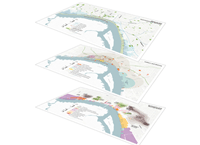
The planning process began with in-depth analysis of the historical, cultural, ecological, and economic contexts. Using existing data, the team created a series of synthetic maps identifying areas of environmental importance, cultural significance and economic opportunity. (Photo: WRT / PennPraxis)

The civic vision revolves around the creation of a comprehensive circulation system which includes Penn’s legacy of a flexible grid. Like William Penn’s plan, the newly designed street network forms urban blocks adaptable to different land uses. (Photo: WRT / PennPraxis)

The vision plan identifies streets with generous rights-of-way as ideal green streets. The street and block orientation in the north and south will shift their orientation to be more perpendicular to the river’s edge. (Photo: WRT / PennPraxis)
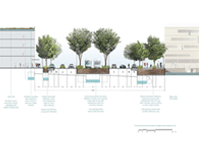
This section illustrates a “complete street,” integrating pedestrians, bicyclists, and transit riders into a grand civic boulevard. Green infrastructure for stormwater management includes collection and use of grey water, rain gardens, and porous paving for the curbside parking. (Photo: WRT / PennPraxis)
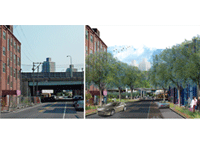
A comprehensive “green streets” approach is illustrated along Frankford Avenue, with a reconstructed I-95 viaduct, LED lighting, a linear park, community facilities, and rain gardens that lead pedestrians and bicyclists to the waterfront greenway and park system. (Photo: WRT / PennPraxis)
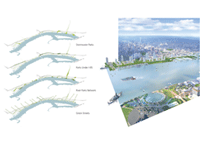
Depicted is an open-space network that integrates new stormwater parks at the river’s edge, parks under I-95, and small neighborhood-focused parks. Parks and open space systems extend into the community through green streets, linking neighborhoods to the riverfront. (Photo: WRT / PennPraxis)
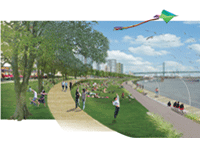
The central riverfront park allows the grid of the city to come to the river in an elegant way. A simple and flexible great lawn provides a gathering space for everyday enjoyment as well as celebrations. (Photo: WRT / PennPraxis)
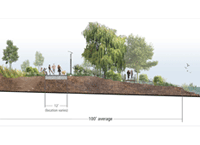
The civic vision recommends a 100-foot wide (on average) riparian edge as recommended by the Environmental Protection Agency. For urban rivers, this is the minimum buffer width required for trapping sediments and providing generalized habitats, and added flood protection. (Photo: WRT / PennPraxis)
"Very believable and effective. Lots of small solutions presented in a very direct way--it's full of possibilities. Truly confident and convincing."
— 2009 Professional Awards Jury

Visitors to the river trail will be able to experience a restorative ecological process over time, as the piers and floating tidal wetlands become viable habitats for birds and native plants. (Photo: WRT / PennPraxis)

The viaduct is transformed into a major regional open-space connector, with an extensive green network enhanced by acknowledging historic streams and creeks. The area becomes a major watershed feature, absorbing runoff and filtering stormwater through infiltration. (Photo: WRT / PennPraxis)

Recommended Improvements to Penn Treaty Park include the creation of a naturalized edge and a connection to the proposed greenway. The greenway and new paths help this green space retain its value as an important community asset. (Photo: WRT / PennPraxis)
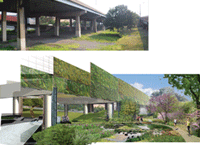
The space beneath I-95 at the newly designed Girard Avenue Interchange is conceived as a neighborhood park that features filtered stormwater runoff, planted sound walls to mitigate noise and air pollution, and LED lighting beneath the structure. (Photo: WRT / PennPraxis)

. North of the port, a riverfront park provides an opportunity for a tidal wetland restoration project that connects to a stormwater management design and helps combat a high level of impervious surface, while elevating the 500-year flood plain. (Photo: WRT / PennPraxis)
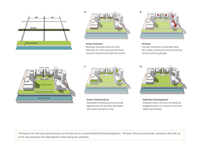
The lessons from this city’s planning history are the basis for our recommended form-based regulations. The basic infrastructure provides connections from the city to the river and across the redevelopment efforts along the waterfront. (Photo: WRT / PennPraxis)
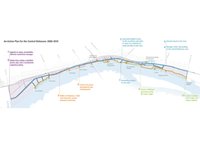
The Civic Vision’s 10-year Action Plan sets forth 10 actions beginning with the establishment of a management agency. Mayor Nutter has endorsed the plan and created the Delaware River Waterfront Corporation who will be responsible for the remaining 9 actions. (Photo: WRT / PennPraxis)



